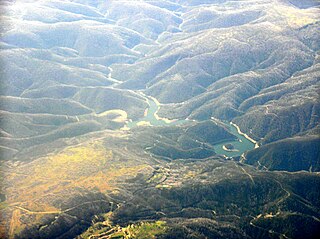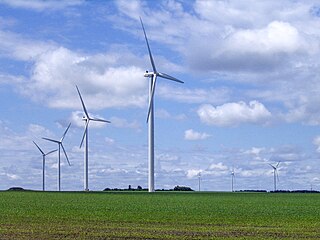
Electricity generation is the process of generating electric power from sources of primary energy. For utilities in the electric power industry, it is the stage prior to its delivery to end users or its storage.

A power station, also referred to as a power plant and sometimes generating station or generating plant, is an industrial facility for the generation of electric power. Power stations are generally connected to an electrical grid.

Electric power distribution is the final stage in the delivery of electric power; it carries electricity from the transmission system to individual consumers. Distribution substations connect to the transmission system and lower the transmission voltage to medium voltage ranging between 2 kV and 35 kV with the use of transformers. Primary distribution lines carry this medium voltage power to distribution transformers located near the customer's premises. Distribution transformers again lower the voltage to the utilization voltage used by lighting, industrial equipment and household appliances. Often several customers are supplied from one transformer through secondary distribution lines. Commercial and residential customers are connected to the secondary distribution lines through service drops. Customers demanding a much larger amount of power may be connected directly to the primary distribution level or the subtransmission level.

A substation is a part of an electrical generation, transmission, and distribution system. Substations transform voltage from high to low, or the reverse, or perform any of several other important functions. Between the generating station and consumer, electric power may flow through several substations at different voltage levels. A substation may include transformers to change voltage levels between high transmission voltages and lower distribution voltages, or at the interconnection of two different transmission voltages.

Manapōuri Power Station is an underground hydroelectric power station on the western arm of Lake Manapouri in Fiordland National Park, in the South Island of New Zealand. At 850 MW installed capacity, it is the largest hydroelectric power station in New Zealand, and the second largest power station in New Zealand. The station is noted for the controversy and environmental protests by the Save Manapouri Campaign against the raising the level of Lake Manapouri to increase the station's hydraulic head, which galvanised New Zealanders and were one of the foundations of the New Zealand environmental movement.

Te Apiti is a wind farm owned and operated by Meridian Energy. It is located on 11.5 km² of land north of the Manawatu Gorge in the North Island of New Zealand. At 90.75 MW, it was New Zealand's largest capacity wind farm until September 2007, when the third stage of the nearby Tararua Wind Farm was completed.

Iberdrola is a Spanish multinational electric utility company based in Bilbao, Spain. Iberdrola has a workforce of around 34,000 employees in dozens of countries on four continents serving around 31.67 million customers. Subsidiaries include Scottish Power and a significant part of Avangrid, amongst others. In 2013, the largest shareholder of the company was Qatar Investment Holding. Other significant shareholders included Norges Bank, Kutxabank and Bankia.

Tumut Hydroelectric Power Station is a series of three of the original four, now five hydroelectric power stations on the Tumut River in New South Wales, Australia, that are part of the Snowy Mountains Scheme.

By year end 2015 Spain was the world's fifth biggest producer of wind power with 23,031 MW installed capacity, providing 48,118 GWh of power and 19% of the country's total electricity production in that year. In 2014, a record breaking year for renewable electricity production, wind power accounted for 20.2% of total electricity generation in Spain making it the second most important electricity source after nuclear power (22%) and ahead of coal power (16.5%). In earlier periods wind energy covered 16% of the demand in 2010, 13.8% in 2009 and 11.5% in 2008.

Hoosac Wind Power Project is a wind farm on Crum Hill in Monroe, Massachusetts and on Bakke Mountain in Florida, Massachusetts. Owned and operated by Iberdrola Renewables, it is the largest wind farm in Massachusetts, with 19 GE 1.5 MW wind turbines and a total installed capacity of 28.5 MW. The Hoosac Wind power project became fully operational in 2012, and provides enough electricity to power 10,000 homes annually.

Biglow Canyon Wind Farm is an electricity generating wind farm facility in Sherman County, Oregon, United States. It is owned by Portland, Oregon-based Portland General Electric and began operations in 2007. With the completion of phase 3 of the project it has a generating capacity of 450 megawatts. It is located roughly five miles (8 km) northeast of Wasco, Oregon, and about ten miles (16 km) southeast of Rufus, Oregon. Biglow Canyon Wind Farm covers 25,000 acres (10,000 ha) in the Columbia River Gorge.
El Marquesado Wind Farm has a capacity of 198 megawatts (MW) and is Spain's second largest wind farm, located in Granada. With an annual output of 450 gigawatt hours, the El Marquesado complex encompasses four wind farms, each with a capacity of 49.5 MW. All four sites use Gamesa 2 MW turbines. The facility cost some EUR 250 million to develop.
The Gunning Wind Farm project is a wind farm development in the Cullerin Range, north-east of Gunning, in New South Wales. Wind turbines in the farm are visible from the Hume Highway.

The Fântânele-Cogealac Wind Farm is the largest onshore wind farm in Romania and in Europe, with installed nameplate capacity of 600 MW from 240 General Electric 2.5xl wind turbines. The wind farm has been built for the ČEZ Group.

The Hau Nui Wind Farm is a 15-turbine wind farm located approximately 21 kilometres (13 mi) south-east of Martinborough, in the South Wairarapa District of New Zealand. Hau Nui was the first wind farm built in New Zealand.

The Tilbury power stations were two thermal power stations on the north bank of the River Thames at Tilbury in Essex. The 360 MW dual coal- and oil-fired Tilbury A Power Station operated from 1956 until 1981 when it was mothballed, prior to demolition in 1999. The 1,428 MW Tilbury B Power Station operated between 1968 and 2013 and was fueled by coal, as well as co-firing with oil and, from 2011, biomass. Tilbury B was demolished in 2016-19. Since 2013 three other power stations have been proposed or constructed in Tilbury.

St. Leon Wind Farm is Manitoba's first wind farm, in St. Leon, Manitoba, Canada. In the first phase completed in 2006, 63 wind turbines were erected over a 93-square-kilometre (36 sq mi) area, capable of delivering 99 megawatts (MW). In 2011 a further 10 turbines were purchased, expanding the capacity of the project to 120 megawatts.
Coopers Gap Wind Farm is a 453 megawatt wind farm in the Western Downs and South Burnett regions of Queensland, Australia. It is located approximately 175 km north-west of the state capital Brisbane, and 50 kilometres south-west of Kingaroy and 65 km north of Dalby.

In 2016, Arizona had 268 megawatts (MW) of wind powered electricity generating capacity, producing 0.5% of in-state generated electricity.
Taiba N'Diaye Wind Power Station,, is a 158.7 MW (212,800 hp) wind power plant in Senegal. When completed, as expected in 2020, the power station will be the largest wind power station in West Africa.
















